Road rules
Seatbelts and Child Restraints
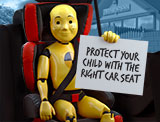

Child restraint laws
When travelling in a motor vehicle in South Australia, all children under 16 years of age must be restrained in a suitable approved restraint that is properly adjusted and fastened.
The law is specific about what type of restraint is to be used at different ages and where children must be seated in a vehicle. The aim of these laws is to reduce the risk of injury caused by restraints that are unsuitable for a child's size.
The driver is responsible for ensuring all passengers are correctly restrained. Penalties include expiation fees and demerit points.
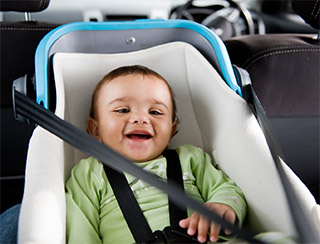 Children up to the age of 6 months
Children up to the age of 6 months
- Must use an approved rear-ward facing infant restraint.
- Must not travel in the front seat of a vehicle that has two or more rows of seats. More
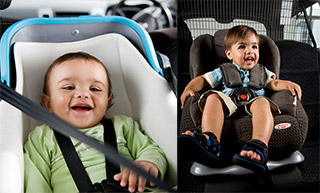 Children 6 months up to 4 years
Children 6 months up to 4 years
- Must use either an approved rear-ward facing infant restraint or a forward-facing child safety seat with an inbuilt harness.
- Must not travel in the front seat of a vehicle that has two or more rows of seats. More
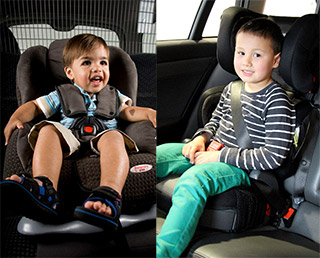 Children 4 years up to 7 years
Children 4 years up to 7 years
- Must use either an approved forward-facing child safety seat with an inbuilt harness, or a booster seat with a properly fastened and adjusted lap-sash seatbelt or child safety harness.
- Must not travel in the front seat of a vehicle that has two or more rows of seats, unless all the other seats are occupied by children who are also under 7 years. More
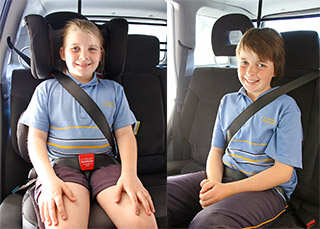 Children 7 years up to 16 years
Children 7 years up to 16 years
- Must use either an approved child restraint (a child safety seat or booster seat depending on their size), or a seatbelt that is properly adjusted and fastened. More
An adult seatbelt won't generally fit a child properly until they are at least 145cm tall. Children should remain in a booster seat until they can wear a seatbelt safely.
Child restraint laws are based on age (rather than by height or weight) because research indicates that this is easier for parents to follow and will result in the smallest number of children being inappropriately restrained. However, a child's height and weight are still important to consider when making a choice about the right restraint or booster seat for your child. For example, the law specifies that –
- If a child is too tall or heavy for the restraint specified for their age, they may use the restraint specified for the next age group.
- If a child is too small to advance into the restraint for their age, they should remain in the restraint specified for the previous age group until they have outgrown that restraint.
Approved child restraints

Child restraints must comply with the Australian/New Zealand Standard 1754 and must be marked accordingly. This Standard is one of the toughest in the world, so child restraints manufactured to this Standard offer good protection in a crash. Restraints bought in other countries will not meet the Australian Standard and it is illegal to use them in Australia.
In 2010, weight guidelines were replaced with shoulder height markers on restraints. These shoulder height markers determine when a child can start using a restraint, or when a restraint needs to be converted to a different mode and when a child may stop using the restraint and move to the next type.
ISOFIX compatible restraints may be used, providing they are Australian Standards approved. The Australian Design Rules for vehicles provide an option for ISOFIX low anchorages in the vehicle with a corresponding top tether anchorage point. A pair of ISOFIX compatible lower attachment connectors for rearward and forward facing child restraints is provided as an option in the Australian/New Zealand Standard for child restraints (AS/NZS 1754:2013) in addition to the top tether strap. Seats made with the new system will also have the current seatbelt system so they can still be used when ISOFIX is not available in the car.
Children with with disabilities and medical conditions
Many children with disabilities and medical conditions can travel safely and comfortably in approved child restraints.
However, some children might need extra support from products specifically designed or modified for children with disabilities and medical conditions. For example, a special purpose child restraint, or an approved child restraint that has been modified to meet a child’s needs when travelling in plaster (e.g., hip spica cast). Trained health professionals, such as occupational therapists and physiotherapists, can assess children’s needs and recommend the best approach.
For a child to legally travel in a non-approved child restraint families must obtain a medical practitioner certificate. The Australian Road Rules also allow a child up to the age of seven years to travel in the front seat, if needed, due to their disability or medical condition. If applicable, this must be included in the child’s medical certificate. But remember, children are always safer in the back seat.
On 30 March 2024, the prohibition on selling non-approved child restraints was removed enabling families of children with disabilities and medical conditions to access non-approved child restraints. There is no longer a requirement to have vehicles and non-approved child restraints inspected.
Seating children in the front seat
- Children aged under 4 years must not travel in the front seat if a car has two or more rows of seats.
- Children aged between four years and up to seven years may travel in the front seat if a car has two or more rows of seats, provided they use an approved restraint (e.g. a booster seat) and only in the following situations:
- all rear seats are being used by children aged under 7 years.
- there is not enough space to put a third restraint in the back seat.
In this situation you will need to use a booster seat that is manufactured without a top tether strap as anchorage points are not available for the front seat.
See Children with Disabilities and Medical Conditions for further information about seating a child with a disability or medical condition in the front seat under certain conditions.
In this situation you will need to use a booster seat that is manufactured without a top tether strap as anchorage points are not available for the front seat.
- Children aged seven and over may legally sit in the front seat of a motor vehicle that has two or more rows of seats, providing they are appropriately restrained for their size. However children are at a greater risk of serious injury when travelling in the front seat. The National Child Restraint Guidelines recommend children 12 years of age and under are safest in the rear seat, regardless of the type of restraint they are using.
If your car has only one row of seats (for example, a ute) children may travel in the front row provided they use an approved child restraint or booster seat. If a child must travel in the front row where there are airbags present, you should always follow the instructions from both the child restraint and vehicle manufacturer. A rearward facing child restraint must not be used in the front seat where there is a passenger airbag. You will also need to check whether an anchorage point is available (for rearward and forward facing child safety seats) before the restraint can be used. Contact a Child restraint fitting centre for further advice.
Children are safer when travelling in the back seat. So no matter what your child's friends are allowed to do or how much pressure your child is putting on you to sit in the front, keep their safety a priority and buckle them up in the back seat.
The law may not require them to sit in the back seat once they turn seven years old, but you can.
Exemptions from the child restraint laws
Bus - bus drivers are exempt from ensuring passengers under 16 years of age are restrained. A bus is defined as a motor vehicle designed to carry over 12 adults (including the driver). If a vehicle is designed to carry 12 adults or less (including the driver) it is not a bus and the driver is not exempt from ensuring all passengers are appropriately restrained.
Taxis - In South Australia, taxi drivers are not required to provide child restraints or booster seats. We recommend you provide your own child restraint when travelling in a taxi or look for an alternative service that can provide an appropriate child restraint.
If there is no suitable approved child restraint available, a taxi driver must ensure:
- All children under seven years are seated in the rear row in a vehicle that has two or more rows of seats – no exceptions.
- Children aged under one year may sit on the lap of another passenger who is 16 years old or older in the rear row, but not between the passenger and the seatbelt;
- Children aged between one year and up to seven years are seated in their own seat in the rear row with a seatbelt fastened to the best extent possible given the passenger's size; and
- Children aged from seven years up to 16 years are wearing a seatbelt.
Other exemptions include:
- Motorbikes.
- A person for whom a certificate signed by a medical practitioner is produced by the driver of the vehicle*.
- A person for whom a certificate of exemption issued by the Minister for Transport is produced by the driver of the vehicle*.
- Children with disabilities and medical conditions being able to travel in non-approved child restraints, and to sit in the front seat, if the driver is carrying a medical certificate. See Children with Disabilities and Medical Conditions.
*These exemptions do not apply if the certificate is not produced on request by the driver of the vehicle.
Ride sharing and limousines
The driver of a ride sharing service, such as Uber, does not have an exemption from the child restraint laws and so must comply with all of the requirements for children up to 16 years of age. This includes limousine services as well.
Some ride sharing services may provide a car seat for a surcharge and others won’t, so be sure to check with the company before booking. If you don’t notify the company that a child will be travelling with you then they may refuse service on pick up if you don’t supply a child restraint yourself.
More information
- Read The Driver's Handbook for information about road rules in South Australia
- Offences and penalties
- Aboriginal child restraint promotional poster [PDF 2.7MB]
- Aboriginal child restraint brochure [PDF 5MB]
Choosing and fitting a child restraint
Children need different child restraints as they grow to offer maximum protection in the event of a crash. Many deaths and injuries occur each year that could be prevented or reduced if the right child restraint is used correctly.
Child restraint fitting services
RAA Safety Centre
101 Richmond Road, Mile End
Phone: 8202 4592 (advice, buying and fitting child restraints)
Kidsafe SA Inc, Hilton Centre
6/69 Sir Donald Bradman Drive
Phone: 7089 8554 (advice, hire, sales, child restraint fitting services)
Kidsafe SA Inc, Women's and Children's Hospital
72 King William Road, North Adelaide
Phone: 8161 6318 (advice)
For special purpose child restraints speak with your health professional or contact MACA who can connect you to help:
Mobility and Accessibility for Children in Australia Ltd. (MACA)
Phone: 03 9134 2500
Safety tips for using seatbelts and child restraints
Keep your kids safe in the car. Check that their car seat is:
- the right type for their age and size
- properly adjusted and fastened to fit the child's body
- correctly fitted to the vehicle. Your child will not be protected properly in a crash if the harness is loose or the restraint is not attached securely to the vehicle.
Also check that the straps lie flat - not twisted, and that they do not touch the child's face or neck and the buckle and adjusters work. Be sure not to over-tighten the top strap as this will result in the lap part being incorrectly pulled up over the abdomen. Regularly check that the seatbelt used to secure the child restraint has not been unlatched by other passengers.
Choosing the safest child restraint for your child
- All child restraints sold in Australia must meet the Australian Standard AS 1754. However, independent testing has shown that some restraints provide more protection and are easier to use than others. You can compare child car seats at https://www.childcarseats.com.au/
- When choosing a child restraint consider the following
- suitability for the child in relation to their age, weight and size
- size of the seat and vehicle
- restraint's features, materials and ease of fitting warranty and after sales service and advice.
- A child's age, height and weight must be considered when choosing a restraint or booster seat. They should grow out of one type of restraint before moving up to the next type of restraint.
- There are special purpose child restraints sold in Australia for Children with Disabilities and Medical Conditions, that have been independently assessed by MACA’s Australian Safety Assessment Program. You can visit MACA’s national product register to learn more.
Tips for buying or hiring a child restraint
- Child restraint fitting services can provide information and advice on purchasing, hiring and installing a child restraint.
- If you are considering a second hand child restraint, be very careful. Only use a restraint when you know its history or if it has been obtained from a reliable source. Check that all parts, including the instruction booklet, are included. Do not accept a child restraint that has been involved in a crash, even if there is no obvious damage, or a restraint that has splits, cracks or large stress marks in the plastic shell, straps that are frayed, worn or damaged, or bent or worn buckles. Child restraints that are more than 10 years old should not be used.
- When hiring a child restraint, check for signs of wear or possible damage.
- Booster cushions (with no seat back or side wings) are not recommended as they provide no protection for children in a side impact crash.
- A Child Safety Harness is not an inbuilt harness. It is purchased as a separate item and is attached to a child restraint anchorage point.
- A child safety harness is difficult to fit correctly and is commonly misused. Do not use a child safety harness where a lap-sash seatbelt is available. Research recommends using a child safety harness only when it is not possible to replace your lap-only seatbelt with a lap-sash seatbelt.
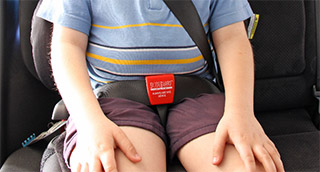 If you are not able to replace your lap-only seatbelt you will need to use a child safety harness with a booster seat. In this case, it is recommended you use a booster seat with an anti-submarining feature to hold the lap part of the seatbelt down low on the child's hips.
If you are not able to replace your lap-only seatbelt you will need to use a child safety harness with a booster seat. In this case, it is recommended you use a booster seat with an anti-submarining feature to hold the lap part of the seatbelt down low on the child's hips.
Be firm about restraint wearing. If your child refuses to use the restraint, or unclips the buckle, don't start the car.
Fitting a child restraint or booster seat
Always follow the manufacturer's instructions when installing a child restraint or booster seat in your car. A restraint which has been incorrectly fitted or is not suitable for your child's size, puts your child at a higher risk of serious injury or death in a crash.
If you need help fitting your restraint, contact the manufacturer or visit a child restraint fitting service.
Disability product suppliers are specialists in fitting products such as special purpose child restraints. Talk to a health professional about getting help from a disability product supplier.
Vehicle issues
- Consider a car with a centre lap-sash seatbelt because the centre seat is safest. You can have a lap-only belt replaced with a lap-sash belt in some cars, but make sure there's a centre rear anchorage point if you want to use that position for a restraint.
- Check that the seatbelts are long enough to use with your child restraint when it's in the recline position and when using a child safety harness with a booster.
- Choose a car that will carry the number of restraints you need. Not all cars have wide enough back seats to carry three restraints at once.
Station wagons
- Fit a cargo barrier that complies with Australian Standards. Ensure that the cargo barrier has the required opening for the upper tether strap to pass through to the anchorage point.
Hatchbacks
- Check there's a clear path between the back seat and the rear anchorage point so the parcel shelf doesn't interfere with adjustment of the tether strap.
- Luggage and some large items carried in the back often obstruct top tether straps.
- Some hatchbacks can also be fitted with cargo barriers or cargo nets.
People movers
- Child restraints may reduce the seating capacity in some people movers, so make sure the restraint won't interfere with your requirements.
- People movers don't always have anchorages for each seating position. Check this first, especially if you are going to carry a number of children in restraints.
Two-door cars
- It's often difficult to fit and use restraints in two-door cars. You may also hurt your back getting children in and out.
Small cars
- A small car may not have enough room to comfortably fit a convertible restraint and a front passenger at the same time.
Dickie seats in cars
Dickie seats may provide a good seatbelt fit for small passengers, however they do not offer the same level of protection as a booster seat as there's no side impact protection.
If the vehicle is fitted with an additional row of seats in the cargo space, known as 'dickie seats', and these are specifically constructed for children, you can use these seats to carry children between the ages of four and seven years.
- A child aged between four and seven years using a dickie seat must be restrained by a lap-sash seatbelt or lap-belt used in conjunction with a child safety harness. Note: Not all dickie seats have anchor points to enable the correct installation of a harness.
- Booster seats cannot be used on dickie seats as they lift the child too close to the roof of the vehicle.
If the dickie seats are designed for carrying adults, then a child restraint is required for children under the age of seven years. Some restraints, such as child safety seats, require an anchor point but others may not. Not all dickie seats are fitted with anchor points and therefore may not be suitable for use with child restraints. The type of restraint will depend on the age and size of the child.
If you are unsure whether the dickie seat has been designed for adults or children or if you are required to use a child restraint contact a child restraint fitting service for advice.
Children up to the age of 6 months
 Children up to six months old:
Children up to six months old:
- must use an approved rear-ward facing infant restraint.
- must not travel in the front seat of a vehicle that has two or more rows of seats.
The restraint must be properly installed and adjusted to fit the child's body. The harness should be adjusted to fit the baby as snugly as possible, with the shoulder and the crotch strap fastening between the baby's legs. Blankets should only go on after the harness is securely fastened.
All rearward facing child restraints must be held in place by the seatbelt and the top-tether strap, and must have an inbuilt harness.
A rearward-facing infant restraint allows a child to lie down and, in a crash, gives support and protection to the head and neck, the most vulnerable parts of a child's body.
A rearward-facing restraint can be fitted to a vehicle with only one row of seats (e.g. a utility or van) provided it does not have an airbag in that position and a child restraint anchorage point is available.
Never use a rearward-facing child restraint in the front seat where there is a passenger airbag.
See Children with Disabilities and Medical Conditions for laws and exemptions about transporting children with disabilities and medical conditions.
Children 6 months to 4 years
 Children six months to four years:
Children six months to four years:
- must use either an approved rearward-facing restraint or forward-facing child safety seat with an inbuilt harness
- must not travel in the front seat of a vehicle that has two or more rows of seats.
When a child turns six months old it does not necessarily mean they are ready to be placed in a forward-facing child safety seat.
As rearward-facing travel is safer, you should only move your child to a forward-facing child safety seat when they have reached the maximum weight limit (for older seats) or the shoulder height marker (for newer seats) of their rearward-facing child restraint.
There are a number of rearward-facing restraints available that are suitable for children to use until approximately 12 months of age.
The restraint must be properly installed and adjusted to fit the child's body.
Only move your child to a forward-facing child restraint when they have outgrown their rearward-facing child restraint.
See Children with Disabilities and Medical Conditions for laws and exemptions about transporting children with disabilities and medical conditions.
Children 4 years up to 7 years
 Children aged between four years and up to seven years:
Children aged between four years and up to seven years:
- must use either an approved forward-facing child safety seat with an inbuilt harness, or an approved booster seat restrained by a correctly adjusted lap-sash seatbelt (or an approved child safety harness in cases where a lap-only belt is fitted) that is properly installed and adjusted to fit the child's body.
- must not travel in the front seat of a vehicle that has two or more rows of seats unless all the other back seats are already occupied by children under 7 years, or there is not enough space to put a third restraint in the back seat, or there are no seatbelts fitted in the back seat. However children must still be in an approved restraint (e.g. booster seat) when they are sitting in the front seat. You will also need to use a booster seat without a top tether strap as anchorage points are not available for the front seat.
Check your child's size and weight before moving them into a booster seat.
Children grow at different rates. A four year old child may not be ready for a booster seat yet. Your child should only progress to a booster seat if they are:
- over the maximum weight limit (for older seats), or
- taller than the shoulder height marker of their forward-facing child safety seat (for newer seats).
Integrated Booster Seats
Children aged 4 years or older can use an integrated booster seat when travelling in a car in South Australia. Integrated (or integral) booster seats are those that have already been built into the seat of the car at the time of manufacture and in accordance with Australian Design Rules. They can be adjusted so that an adult or a child aged 4 years or older can travel in the seat.
Although an integrated booster is legal to use and helps the child to wear a seatbelt correctly, it does not provide the head protection that is afforded by using a current Standards Approved booster seat, that is, one with a high back and side-wings.
Using a child safety harness with lap only seatbelts
If you have a seating position with a lap-only seatbelt and need to use a booster seat, you must use the seatbelt in conjunction with a child safety harness. This will stop the child's head and torso from being thrown forward in a crash.
It is recommended to only use a child safety harness on a booster with an anti-submarining buckle.

An anti-submarining buckle prevents a child from sliding under their seatbelt during a crash or heaving breaking. A seatbelt strap is attached to the booster seat and clips to the lap part of the seatbelt (between the child's legs) to stop them from sliding out under the seatbelt.
Children 12 years of age and under are safest in the back seat. If you will need to fit three child restraints in the back seat, contact a child restraint fitting service for advice on the best combination of restraints to use in your car.
See Children with Disabilities and Medical Conditions for laws and exemptions about transporting children with disabilities and medical conditions.
Children 7 years up to 16 years
 Children aged seven years up to 16 years:
Children aged seven years up to 16 years:
- must use either an approved child restraint (depending on their size, this will be a child safety seat or booster seat) or a properly adjusted and correctly fastened seatbelt.
Children in this age group should continue to use an approved child restraint until they are tall enough to wear an adult seatbelt correctly, even if they can legally sit in the front seats.
Car seats and seatbelts are designed for adult bodies, so not all children will fit an adult seatbelt when they reach their seventh birthday. Research shows that an adult lap-sash seatbelt will not generally fit a child properly until they are at least 145cm tall, often around 10-12 years of age.
Children who are not yet tall enough to use an adult seatbelt tend to slump into the vehicle seat so that their legs bend at the seat edge. This means the lap part of the seatbelt is positioned too high on their stomach and they are at risk of serious injury in a crash.
If a child outgrows their current booster seat and is still unable to wear an adult seatbelt correctly, it may be possible to obtain a larger booster seat.
Keep in mind that how the seatbelt fits will also vary from vehicle to vehicle and even from position to position in the same vehicle.
Lap-sash seatbelts provide greater protection than lap-only seatbelts. If there is a lap-only seatbelt in your car, it can be used with a properly fitting child safety harness by a child up to 32kg (approximately 10 years of age). Alternatively you may be able to have the lap-only belt replaced with a lap-sash seatbelt.
Is your child ready for an adult seatbelt?
If you answer "Yes" to all 5 Questions below, then your child is ready to move out of a booster seat, into an adult seatbelt. If you answer "No" to one or more, then they still need a booster seat.
- Can the child sit with their back against the vehicle seat back?
- Do the child's knees bend in front of the edge of the seat?
- Does the sash belt sit across the middle of the shoulder?
- Is the lap belt sitting low across the hips touching the thighs?
- Can the child stay seated in this position for the whole trip?
Children won't fit an adult seatbelt properly until they are at least 145cm tall. Keep them in a booster seat until they are tall enough for the seatbelt to fit correctly.
See Children with Disabilities and Medical Conditions for laws and exemptions about transporting children with disabilities and medical conditions.
Seatbelts
Wearing a seatbelt can be a life or death decision – both for you and your passengers, even if you are only travelling a few kilometres because most road crashes happen close to home.
Wearing a seatbelt when travelling at 40 kilometres is just as important as wearing a seatbelt at faster speeds. Crash impact at 40km/h is like falling from a two storey building onto concrete.
Passengers not wearing seatbelts can kill or seriously injure others in the car if, for example, the driver has to brake suddenly.
Seatbelt laws
- Drivers must ensure that they and any passengers in the vehicle are wearing a seatbelt or approved child restraint. Penalties include demerit points and fines.
- Passengers aged 16 years or older also commit an offence if they do not wear a seatbelt when one is available.
- Seatbelts do not have to be worn if you are carrying a letter from your doctor have a stating that you do not have to wear a seatbelt on the ground of physical disability or any medical ground. The letter must be carried with you whenever travelling in a vehicle, or a seatbelt must be worn.
Note: Animals should also be suitably restrained in vehicles. It is also an offence for passengers to travel in the back of utes, panel vans, trailers and caravans.
Pregnancy
 No matter what stage of your pregnancy, it is vital that you always wear a seatbelt. This will protect you and your unborn baby in the event of a crash.
No matter what stage of your pregnancy, it is vital that you always wear a seatbelt. This will protect you and your unborn baby in the event of a crash.
Wear your seatbelt comfortably and correctly with the lap part of your seatbelt worn as low as possible, positioned below your baby. It should be over the upper thighs and across the pelvis. The sash part of your seatbelt should pass above the stomach and across the centre of your chest.
More information
- Read The Driver's Handbook for information about road rules in South Australia
- Offences and penalties





























